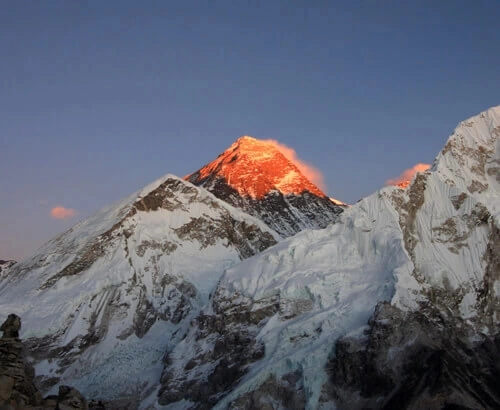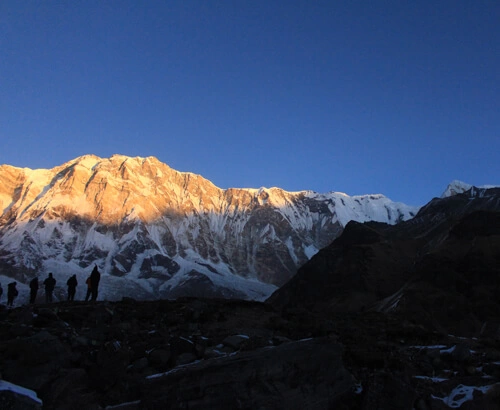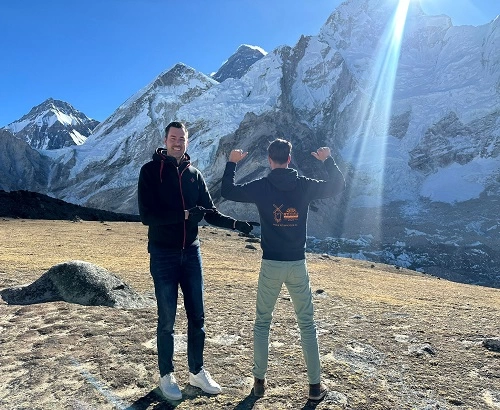Trek to EBC is all about Adventure. That is to say, it's not a luxury Trek, but instead, it's a lifetime experience of adventure, Nature, culture, and spirituality. EBC Trek is also the favorite destination for thousands of tourists around the globe who come to Nepal every year. Everest Base Camp Trek is one of the most popular treks in Nepal. Fly to Lukla (one of the world's highest altitude airports) and meet and interact with Sherpa people who are known for their hospitality in places like Namche Bazaar; hike up towards the base camp region of magnificent Mount Everest alongside views from Kala Patthar and Khumbu Icefall.
Everest Base Camp Trek is a heaven for trekkers. Every wanderer wants to move on the path of the Everest region of Nepal and make eye-to-eye contact with the world’s highest mountain. Traveling is also quite adventurous, as we will be on the road for approximately 15 days. It is well known that one of the most renowned trekking routes in the world, Everest Base Camp trek, offers you fairy tale adventure all year round, in spring, autumn, and other seasons, to see the wonder of Mt.Everest. You will witness Sherpa people's lifestyle, Buddhist traditions/culture and festivals, and something fascinating with every step you take.
The first thrilling encounter of your exciting holiday takes place at the Tribhuvan International Airport in Kathmandu. You will be received by our airport representative, waiting for your arrival, with a placard with your name written on it. After welcoming you, he will assist you in transferring to the hotel and scheduling all programs upon your request.
After a day's rest at Phakding, you will have to climb up to Namche Bazaar on this day again before you can see the entrance to Everest. And from Phakding, we will be putting up in another simple tea house where most facilities are elementary. You may not get the electricity or heating facility here. But do not worry; your dining hall will warm up for you during mealtime. The Namche Bazaar is home to a huge village of Sherpa people, and it is common for trekkers to stay for one or two nights here and acclimate. It has beautifully designed streets with multicolored roofs and hundreds of stone stairs leading to small houses that run in tandem with Buddhist traditions.
The trail ascends from here and passes via a group of rhododendrons, heading through a forest. Following the forest, the path takes you high over the river and runs numerous times before getting to Tengboche, along with its exceptional monastery. It’s worth relaxing and enjoying the marvelous views of Mount Lhotse and Ama Dablam at Tengboche. From herein, you will hike rather high for Dingboche to acclimate to that altitude for a day before hiking towards Lobuche. Then, after spending one night at Lobuche, you make it to Gorak Shep, another stopover right below Everest Base Camp, where everybody leaves their baggage en route up onto EBC beside the Khumbu Glacier.
Completing Mount Everest Base Camp will leave you with immense satisfaction and achieve one of your life's best adventures. The base camp gives you a good view of the tallest mountains in the world, and in the right season of April-May or October-November, some winter campaigners may see some climbers getting themselves prepared for their campaigns here. The next day, we will trek to Kala Patthar. With our head torches and flashlights, we go out at night. Early in the morning, we again go out with our head torches and flashlights. The scenery is awesome. After that, we move back, following our path up and down for about an hour, and finally reach Gorakshep. We have breakfast there. Then again, starting slowly descending, we reach Lukla, from where we take flight back to Kathmandu.
Best Highlights of Everest Base Camp Trek (14 Days)
- Thrilling flight to Lukla “Tenzing-Hillary Airport,” known as one of the most dangerous airports in the world, located on the Clifftop.
- One Day Namche Bazaar Village Hike & Get Face to Face with Everest, a city full of life. A place you definitely must visit in your lifetime.
- Enjoy coffee at the local tiny bakeries in Namche Bazaar with so many different people around; it is wonderful.
- Get close-up views of Mount Everest (8,848 meters) and see Lhotse, Nuptse, Ama Dablam, and many more.
- View Everest from the top – Hotel Everest View, World’s Highest Airport, Syangboche.Experience the Sherpa people’s rich indigenous culture in Khumbu.
- Visit Tengboche Monastery, the largest monastery in the Khumbu Region, and feel its tranquil spiritual ambiance.
- Hike in Sagarmatha National Park, a UNESCO World Heritage site known for its contrasting landscapes and unique wildlife.
- Stand at the foot of the tallest mountain on Earth that rises to 5,364 m (17,598 feet) when you reach Everest Base Camp stage.
- Watch the best views of Mount Everest and other mountains from Kala Patthar if you are there at sunrise or sunset.
- When you arrive at Namche Bazar, you’ll cross a suspension bridge known as Hillary Bridge. Most of all, trekkers take photographs here.
Is The Everest Base Camp Trek For You?
The Everest Base Camp Trek is labeled as a moderate to tough trek- the difficulty of this trek is highly influenced by the altitude and distances trekked per day. If, for example, you have previously done high-altitude treks – say, the Annapurna Base Camp trek, Poon Hill trek, or Langtang Valley trek then you will find this trip easy. You can do the ever-popular–Everest Base Camp Trek without too much stress if you get the advice right and do proper planning and training.
Proper planning and preparation are important and direct determinants of the trek's outcome. It is best to begin training for your intended physical activities at least one month before your trip. Knowing that you are to reach heights of more than 5000 meters and be trekking up to 7 hours a day, fitness is a crucial physical and mental factor.
It is recommended that to improve endurance, one must involve oneself in activities like running, cycling, or swimming. It is necessary to include strength training to condition muscles for trekking requirements, although remember to use a rehearsal with a loaded backpack. This will improve your physical strength and familiarise yourself with carrying your items and necessities.
If you opt out of the porter, ensure you can easily carry your backpack containing your trek requirements. However, it is advisable to hire a porter. This will help to ease the burden and concentrate on the trekking and the beautiful view of the region.
The best way to avoid altitude sickness is to adjust to the new environmental conditions encountered when one moves up the altitude. Organize the daily itinerary to have rest days and adhere to recommendations from prior hikers or a guide. They can give important advice and help you have a safer and more appealing trekking adventure.
Finally, the EBC Trek is possible for anyone, whether a professional or a beginner, as long as one takes the right precautions and attitudes and gets the appropriate assistance.
What Makes Everest Base Camp Trek One of the Best Destinations in Nepal in 2025/26?
Everest Base Camp Trek is at the top of the list of treks in 2025/26 and many upcoming years. The world’s number one trek fulfills the dreams of thousands of trekkers every year, bringing them face to face with Mount Everest (8,848 meters) and past other great peaks like Makalu, Lhotse, and Cho Oyu. The trek is more exceptional as it is packed with attractions in an experience that takes just 15 days.
See the best of the Everest region, experience the stunning landscapes & Sherpa culture at Everest, and visit historic sites. Be guided from the busy Namche Bazaar to the peaceful Tengboche Monastery, and be somewhere new each day. Finishing at Everest Base Camp gives you a sense of achievement like no other trip in the Himalayas.
Lukla Flight and Tenzing-Hillary Airport: Most Dangerous Airport
The Everest Base Camp Trek starts with an exhilarating flight to Lukla’s Tenzing-Hillary Airport (2,846m) – the launch point for your 15-day trip. That’s the runway considered the most dangerous in the world, so it certainly gets your adventure started on a high. This is where you will start your trek amongst its cliff-top location, and stunning mountain surroundings. A Kathmandu flight may be canceled or delayed sometimes due to poor weather, so we have alternative options for getting you there. Use a helicopter ride for a flight from Ramechap to Lukla or vice versa.
The Famous Hillary Bridge: Suspended Over the Dudh Koshi
Offering trekkers an exhilarating highlight, the Hillary Bridge is one of Nepal’s highest suspension bridges along the Everest Base Camp Trek. It suspends 135 meters (442.9 feet) over the Dudh Koshi River and spans approximately 60 meters (196.85 feet). This modern bridge is positioned on the way to Namche Bazaar. A lower bridge is next to it, which was used before and still draws attention. You can see both new and old bridges side by side from below. Crossing this massive bridge is an exciting entrance into the world of Everest, offering a great view and much more of an adrenaline rush. It marks the beginning of even further endeavors on the trek to the base of Everest.
Namche Bazaar: Sherpa Capital of the Khumbu
Namche Bazaar is 3,440m, resting at the heart of the Himalayas, and is the lively meeting point of the Khumbu region. Initially, it was a commercial center for trade between Nepal and Tibet, but today, it acts as a gateway for people who intend to trek or mountaineering on Mount Everest. The town serves luxurious surroundings while sharing the sherpa lifestyle, which is ideal for trekkers. Tourists can enjoy working around different vibrant-colored markets, cafes, and equipment stores where they can buy or hire anything they might need. Namche Bazaar grants visitors the culture, beauty, and the best acclimatization destination.
Scenic Syangboche Airport and Hotel Everest View
At 3,780 meters in the Khumbu Region of Nepal, Syangboche Airport is one of the high-altitude airports. No longer operational, this airport now exists as a historic site from where you can have a fulfilling view of the Mighty Himalayas. Commence your trek from Hotel Everest View, which comes as an all-in-one package for trekkers wishing to grasp their bare eyes on the world’s topmost peak, Mountain Everest, coupled with its adjacent peaks.
Hotel Everest View Trek can also be taken as an acclimatization trek from Namche Bazaar; this is a short and family-fit trek that endows you with mind-blowing views of Everest, Lhotse, Thamserku, and Ama Dablam after embarking upon shortly-beautiful flight to Lukla. Here, enjoy your delicious breakfast in front of Everest.
Tengboche Monastery: A Place That Hosts Mani Rimdu Festival
Tengboche Monastery, or Dawa Choling Gompa, is a major Tibetan Buddhist monastery on the Everest Base Camp Trek. It’s the biggest and most famous in the region, towering over a hill near where the Dudh Koshi and Imja Khola rivers meet, with Mount Ama Dablam as an astonishing backdrop. It’s best known for hosting the Mani Rimdu festival, a three-day affair where monks perform intricate mask dances symbolizing Buddhism triumphing over Bon.
Reaching to EBC and Kala Patthar's Summit: EBC Trek Best Days
The best EBC trekking days are Reaching Everest Base Camp (EBC) and Kala Patthar's summit. The EBC, a "gateway to Everest Summit," is where expeditions start for an Everest climb. Kala Patthar, or "Black Stone," offers trekkers the most panoramic views of Everest and its neighboring peaks. The journey takes you right into the heart of the giant Himalayas, offering the amazing experience of high soaring mountains as well as Khumbu glacier walking past them, ending at breathtaking views of Nuptse-Changtse and Lhotse beside mighty Everest. You will watch the glistening sunrise golden rays reaching on top, making them look just short distances away.
Lukla Flight Status Throughout the year 2025 and 2026
Flights to Lukla are seasonal, and direct flights from Kathmandu to Lukla are available in January, February, March, May, June, July, August, September, and December. In the remaining months of April, October, and November, flights to Lukla will operate from Manthali Ramechhap, about a 3-4 hour drive by private bus or car.

When Lukla's flights are canceled, there are a few other alternatives.
- Helicopter flight: Fastest but expensive. It takes 40-60 minutes from Kathmandu to Lukla. Cost: $300-$500 per person if shared, or $2,500-$3,000 can be a chartered flight.
- Driving to Phaplu Village or Tham Danda by private Jeep is a long way, but it is more reliable. The road connection drive and trek offer different countryside experiences and local people's hospitality.
- Drive to Jiri and Trek: A historical route known as Pioneer's Route that goes through isolated local villages and diverse landscapes, providing an authentic Nepali impression on your journey.
- Fly from Ramechhap (Manthali) Airport: An alternative to Lukla flights during peak season. A 5-hour drive east of Kathmandu.
Everest Base Camp Trek Cost Facts Related to Guides, Flights, Porters 2025/26
Here, you have complete details of the cost of Everest Base Camp Trek. There are different transportation options, depending on your available budget and time. Helicopter rides are expensive but cut down some travel time and offer incredible views. Guide services are included in the package, although be prepared to have more funds for porter service if needed or desired. The cost may vary based on prices, seasons, and groups.
Transportation:
- Kathmandu to Manthali by Minibus: $15 per person (included in the program)
- Kathmandu to Manthali by Private car/jeep: $180 extra (one way, upon request)
- Helicopter from Kathmandu to Lukla (sharing): $500-$700 per person
- Helicopter from Lukla to Kathmandu (sharing): $500-$700 per person
- Helicopter from Gorak Shep to Kathmandu (sharing): $1,600 per person
- Helicopter from Gorak Shep to Lukla (sharing): $750 per person
Porter costs:
- $20 to $25 per day ( included in the program)
Guide costs:
- $30-50 USD per day (included in the program)
Standard Everest Base Camp Trek Cost, Discounts, and Trip Booking in 2025, 2026, and 2027
The Everest Base Camp Trek also has several packages to accommodate people traveling alone and other big groups. There are different costs associated with the EBC trek as per the number of trekkers in a group.
No of Trekkers | Cost Per Person | |
1 pax | US $1400 | |
2 - 6 pax | US $1320 | |
7- 12 pax | US $1250 |
If you have any questions concerning the price of the Everest Base Camp Trek, don't hesitate to contact us via WhatsApp (at any time).
Discount on Everest Base Camp Trek Package
The packages have been well thought out and planned so that the clients can get the best of the Himalayas at cheaper prices. One such promotion includes a 10% off-season discount on winter treks in January and February for the trekking season 2025-2026. This special discount opens a window of opportunity for trekkers to trek the ever-popular Everest region during the low season when the trails are relatively empty and the views of the Himalayan range are panoramic. Another benefit of winter trekking is that people can celebrate Christmas, New Year, and even Valentine's at the Everest Base Camp and many other exciting things.
Standard packages may vary from each other in price depending on the season of the year, the number of people to be served, and the inclusion of particular facilities. It is advisable to pre-book more so when planning to travel during the peak season. An off-season discount is a wonderful opportunity to spend less for the guests or travel if one wishes to have full control over trekking. To get the latest price list and winter sale offer, the interested traveler is advised to message the tour operator and use WhatsApp for further communication.
Everest Base Camp Trek Permit Cost
You will need permits to enter protected Everest Base Camp Trek areas. The permits you'll need for this trip are as follows:
- Trekker's Information Management System (TIMS): $20
- Pasang Lhamu Municipality Fee: $20
- Sagarmatha National Park Fee: $30
The combined cost for the following necessary permits is $70 per person. Most standard Everest Base Camp Trek packages include these costs in the trip price. It's convenient and means you are following local regulations while enjoying trekking in the Everest region.
Everest Base Camp Trek Cost For Seniors, Indians, and Students
Everest Base Camp Trek Cost for Seniors
Although every senior citizen may desire to trek to the Everest Base Camp, questions of safety and mobility may arise. In this regard, Adventure Altitude Treks has designed a long trekking EBC journey for seniors. This trip is less physically demanding as it covers fewer kilometers per day and more time for acclimatization to increase the chances of avoiding altitude sickness. Senior travelers will be guided by experienced individuals who ought to have adequate knowledge and understanding of the routes.
Everest Base Camp Trek For Students
What can be more adventurous than the opportunity for students to trek Everest Base Camp at a very budget-friendly cost? With this goal, Adventure Altitude Treks offers a 10% discount on their Everest Base camp trekking in a group of students, which makes it easier for school students’ dreams of the Himalayas to come true. Just wander yourself walking from one fantastic village to another, viewing snow-clad peaks, and testing the power of rivers during your base camp trek. The adventure enhances student friendship and offers to taste the beauty of Nepal at a very student-friendly cost.
Everest Base Camp Trek Cost for Indians
Nepal's Everest Base Camp lures trekkers worldwide but is far more affordable for Indian travelers. Permit and travel costs are nearly a third of what other nationalities pay, so the starting prices for the Everest Base Camp trek will be around $ 1300 or much lower per person. The total cost depends on how you travel, the number of days you decide to trek, and how many comforts you'd like. You could also use the open border between India and Nepal and avoid flights by simply hopping onto a train or bus to Kathmandu. For those on a tight budget, the trek can be done in 9-20 days if desired.
Luxury Everest Base Camp Trek Cost
We also organize a Luxury Everest Base Camp trek for those trekkers who want unparalleled luxury along with the Everest hike. The Luxury EBC trek package costs $3150 per person and provides ultimate comfort and a daring experience. With upgraded lodges and transportation and first-class accommodations at every stop, we take all stress out of your travel so that you can focus on enjoying the incredible mountain routes and beauty of the mountains. You get highly professional guides and porters accompanying you while assisting with whatever needs arise during the trek.
Everest Base Camp Cost Per Day For Trekkers
Most importantly, your main costs are included with a guided Everest Base Camp trek. Your meals, accommodation, guide, and even the flight to Lukla will be included in the price you pay for your package. Some additional personal costs you may need to fund yourself during your trip will include around $25-50 per day for snacks, hot water (which is often used for rehydrating meals or drinks), charging your devices (keep in mind that wifi access might be limited on the mountain and come at an extra cost), laundry services, etc. Our service also includes airport pick-up & drop-off and sightseeing around Kathmandu. One of our biggest draws, though, is our ability to provide gear rentals like trekking poles, sleeping bags, and even down jackets, which would save you up to $500.


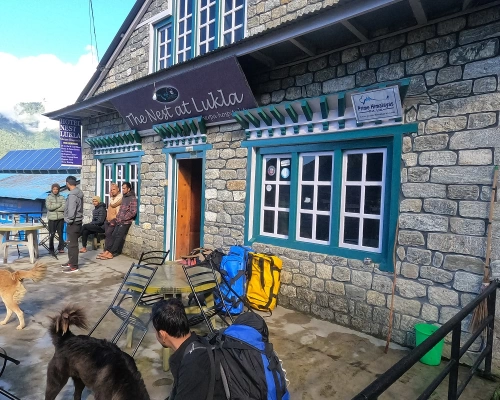

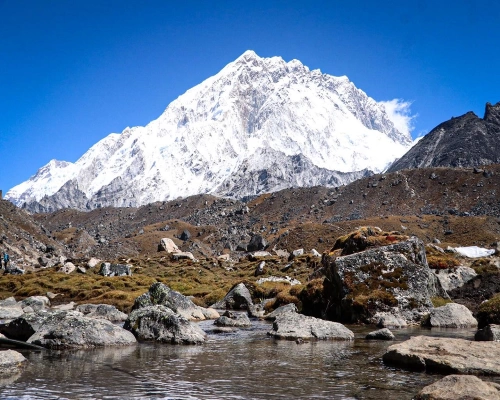
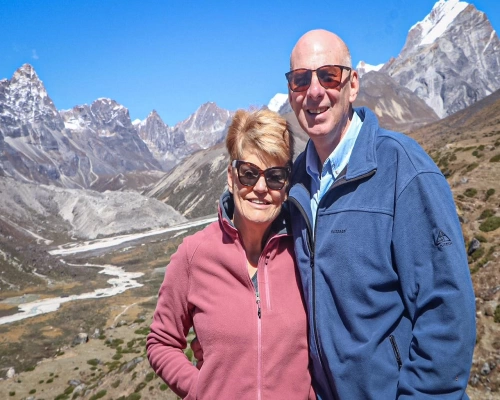
.jpg)
.jpg)


